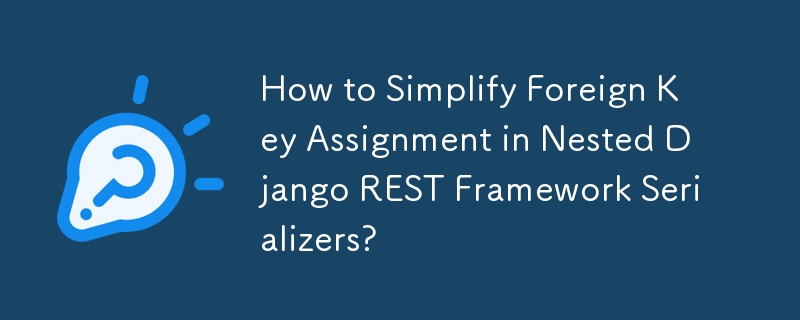 Backend Development
Backend Development
 Python Tutorial
Python Tutorial
 How to Simplify Foreign Key Assignment in Nested Django REST Framework Serializers?
How to Simplify Foreign Key Assignment in Nested Django REST Framework Serializers?
How to Simplify Foreign Key Assignment in Nested Django REST Framework Serializers?
Dec 09, 2024 pm 06:58 PM
DRF: Simplified Foreign Key Assignment in Nested Serializers
Problem:
With Django REST Framework (DRF), a standard ModelSerializer allows ForeignKey model relationships to be assigned or edited by posting an ID as an integer. However, when working with nested serializers, replicating this behavior raises doubts on the best approach.
Solution:
Overriding to_representation() Method
One method to achieve this functionality in a nested serializer is to override the to_representation() method in the parent serializer. This technique has the following advantages:
- No need for separate fields for creation and reading.
- Both creation and reading can be done using the same key.
Sample Parent Serializer with Modified to_representation() Method:
class ParentSerializer(ModelSerializer):
class Meta:
model = Parent
fields = '__all__'
def to_representation(self, instance):
response = super().to_representation(instance)
response['child'] = ChildSerializer(instance.child).data
return responseUsing a Custom Serializer Field
For a more generic solution, consider creating a custom serializer field called RelatedFieldAlternative. This field ensures compatibility with DRF versions 3.x and 4.x.
Custom Serializer Field:
from rest_framework import serializers
class RelatedFieldAlternative(serializers.PrimaryKeyRelatedField):
def __init__(self, **kwargs):
self.serializer = kwargs.pop('serializer', None)
if self.serializer is not None and not issubclass(self.serializer, serializers.Serializer):
raise TypeError('"serializer" is not a valid serializer class')
super().__init__(**kwargs)
def use_pk_only_optimization(self):
return False if self.serializer else True
def to_representation(self, instance):
if self.serializer:
return self.serializer(instance, context=self.context).data
return super().to_representation(instance)Using the Custom Field in the Parent Serializer:
class ParentSerializer(ModelSerializer):
child = RelatedFieldAlternative(queryset=Child.objects.all(), serializer=ChildSerializer)
class Meta:
model = Parent
fields = '__all__'The above is the detailed content of How to Simplify Foreign Key Assignment in Nested Django REST Framework Serializers?. For more information, please follow other related articles on the PHP Chinese website!

Hot Article

Hot tools Tags

Hot Article

Hot Article Tags

Notepad++7.3.1
Easy-to-use and free code editor

SublimeText3 Chinese version
Chinese version, very easy to use

Zend Studio 13.0.1
Powerful PHP integrated development environment

Dreamweaver CS6
Visual web development tools

SublimeText3 Mac version
God-level code editing software (SublimeText3)

Hot Topics
 How Do I Use Beautiful Soup to Parse HTML?
Mar 10, 2025 pm 06:54 PM
How Do I Use Beautiful Soup to Parse HTML?
Mar 10, 2025 pm 06:54 PM
How Do I Use Beautiful Soup to Parse HTML?
 How to Use Python to Find the Zipf Distribution of a Text File
Mar 05, 2025 am 09:58 AM
How to Use Python to Find the Zipf Distribution of a Text File
Mar 05, 2025 am 09:58 AM
How to Use Python to Find the Zipf Distribution of a Text File
 How to Work With PDF Documents Using Python
Mar 02, 2025 am 09:54 AM
How to Work With PDF Documents Using Python
Mar 02, 2025 am 09:54 AM
How to Work With PDF Documents Using Python
 How to Cache Using Redis in Django Applications
Mar 02, 2025 am 10:10 AM
How to Cache Using Redis in Django Applications
Mar 02, 2025 am 10:10 AM
How to Cache Using Redis in Django Applications
 How to Perform Deep Learning with TensorFlow or PyTorch?
Mar 10, 2025 pm 06:52 PM
How to Perform Deep Learning with TensorFlow or PyTorch?
Mar 10, 2025 pm 06:52 PM
How to Perform Deep Learning with TensorFlow or PyTorch?
 Serialization and Deserialization of Python Objects: Part 1
Mar 08, 2025 am 09:39 AM
Serialization and Deserialization of Python Objects: Part 1
Mar 08, 2025 am 09:39 AM
Serialization and Deserialization of Python Objects: Part 1
 How to Implement Your Own Data Structure in Python
Mar 03, 2025 am 09:28 AM
How to Implement Your Own Data Structure in Python
Mar 03, 2025 am 09:28 AM
How to Implement Your Own Data Structure in Python







